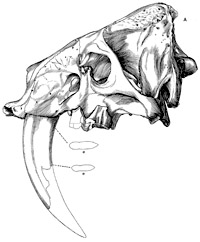Museum, University of Nebraska State
Date of this Version
1957
Document Type
Article
Citation
The University of Nebraska State Museum VOLUME 4, NUMBER 4 Pp. 59-81, Figs. 1-7
Abstract
The accurate geologic dating of Pleistocene vertebrate localities which occur outside the glaciated regions has always been difficult. Several new fossil localities in Nebraska now provide data for a better understanding of the paleoecology and faunal evidence of the medial Pleistocene of the Great Plains region.
A fossil quarry, containing the remains of both vertebrates and invertebrates, has been discovered in south-central Nebraska (11/2 miles south and west of Angus in Nuckolls County). The fossils are preserved in Sappa silts in a lime concentration zone (C horizon) of a Yarmouth paleosol. The calcium carbonate appears to have been responsible for the preservation of fragile invertebrate as well as vertebrate fossils. The mammalian remains range from small rodents to large proboscideans. Fossilized specimens of fish, reptiles, amphibians, and birds also are present in the deposit. The importance of this locality is emphasized because of its nearness to the glacial till border (less than forty miles), thus enabling a more definite geologic dating of the fossils. A second fossil quarry, with a similar faunal assemblage and also associated with a Yarmouth paleosol, has been located twenty-six miles north of Lincoln in Saunders County, Nebraska. This locality is within the Kansan till border and is definitely post-Kansan and pre-Illinoian. The faunas from both localities compare favorably with the well-known "Equus beds" fauna from Sheridan County, Nebraska, thus confirming the medial Pleistocene dating for the latter faunal assemblage.
The geomorphologic and stratigraphic evidence at the above mentioned localities (Nuckolls, Saunders, and Sheridan counties) demonstrates that these fossil deposits are medial Pleistocene in age and occur in the lower part of the Terrace-4 fill.
Included in
Entomology Commons, Geology Commons, Geomorphology Commons, Other Ecology and Evolutionary Biology Commons, Paleobiology Commons, Paleontology Commons, Sedimentology Commons

